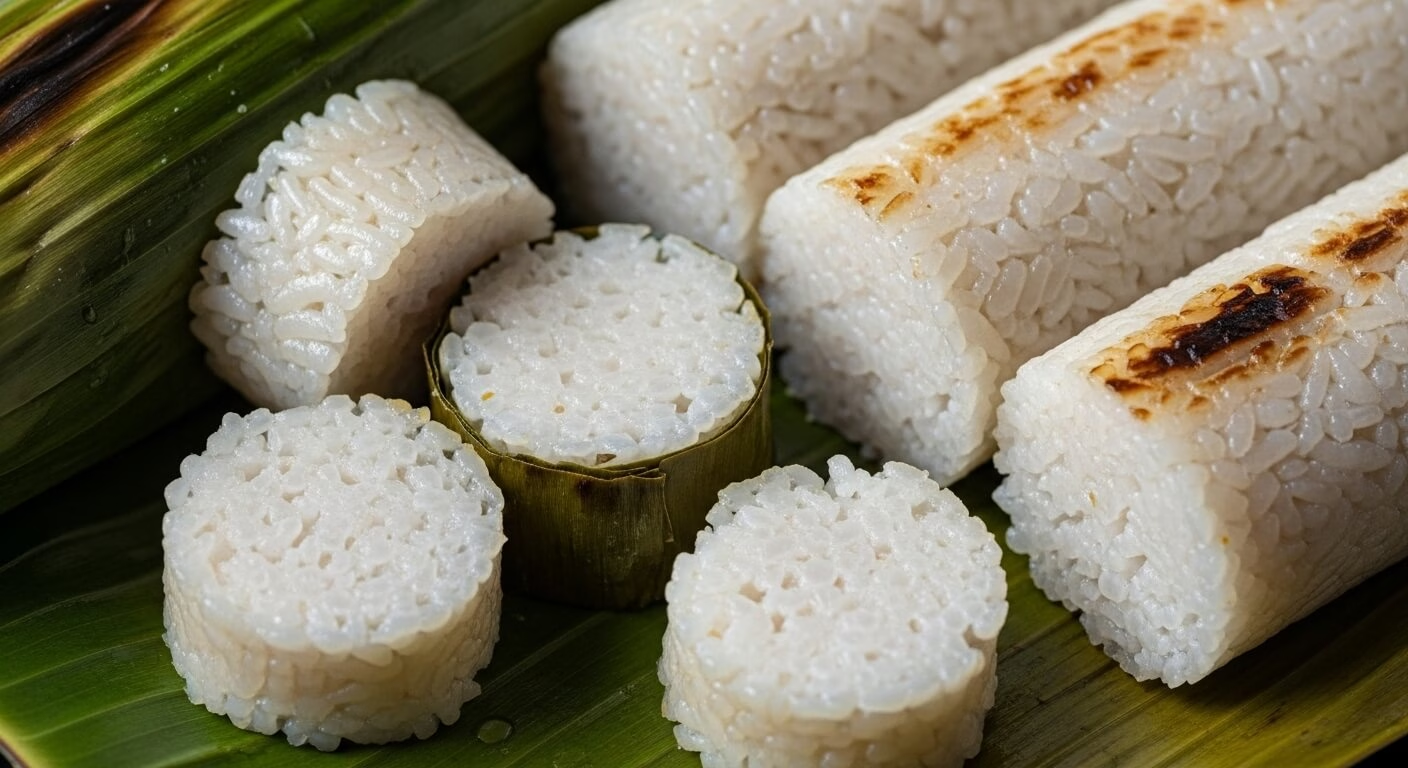Easy Lontong Recipe – Indonesian Rice Cakes
Traditional Indonesian Lontong: Banana Leaf Rice Cakes Made Easy – I’ll never forget the first time I watched my Indonesian neighbor, Ibu Sari, make lontong in her tiny Brooklyn kitchen.

Lontong (Indonesian banana leaf compressed rice cake)
Ingredients
- 2 pandan leaves (fresh or frozen)
- 5 inch about 13 cm. section of fresh lemongrass
- 2 cups jasmine rice
- 3 ½ cups water
- ½ teaspoon salt
- 6 banana leaves (20x35 cm. banana leaf sections)
Instructions
- Tie the pandan into a knot, then smash the lemongrass with the side of a heavy knife or a meat tenderizer to help both release their flavor into the rice when cooked.
- Add the water, pandan leaves, lemongrass, and salt to a pot and bring to a boil over medium-high heat.
- Stir in the jasmine rice, reduce heat to low, cover, and simmer 15–20 minutes until the rice is fully cooked and the water is absorbed. Remove the pandan leaves and lemongrass, then let the rice cool for at least 20 minutes so it’s easy to handle.
- Cut the banana leaves into three equal pieces, about 8 inches by 14 inches each. Rinse with very hot water to bring the oils to the surface and make them pliable, then pat dry with a clean towel.
- Place one piece of banana leaf on a flat surface—shiny side up if you want more green coloring on your rice cakes, down if you want less. Add about 1 cup cooked rice to the center. Fold the leaf in half to cover the rice, then fold the sides inward to create a sealed package. Secure with twine or toothpicks. Repeat with the remaining banana leaves and cooked rice; this makes six lontongs.
- Bring a large pot of water to a boil. Add the wrapped rice packages, ensuring they are fully submerged, and cook for 1 hour.
- Remove the lontong from the pot and refrigerate for at least 90 minutes before unwrapping so they fully solidify.
- Cut the lontong into small pieces and serve with your favorite side dishes.
Nutrition
There I was, thinking I was pretty accomplished in the rice department—I could make a decent risotto, my pilaf game was strong, and I’d even mastered the art of not burning jasmine rice in my temperamental rice cooker.
But watching her transform simple rice into these gorgeous, compressed jade-green cylinders wrapped in banana leaves? That was pure magic, and I knew I was witnessing something special.
She moved with such confidence, bruising lemongrass stalks with the side of her knife, tying pandan leaves into neat little knots like she was preparing tiny green bow ties for a doll’s formal dinner.
“The secret,” she told me in her soft voice while folding banana leaves around mounds of aromatic rice, “is patience.
Americans always want to rush the rice.” She wasn’t wrong—I was already mentally calculating how I could speed up the process, maybe use my Instant Pot, definitely skip the chilling time.
But as I watched her work, methodically wrapping each portion and securing it with kitchen twine, I realized this wasn’t about efficiency.
This was about creating something that would become the foundation for countless Indonesian meals, a canvas for rich curries and spicy sambals.
The smell that filled her kitchen as those banana leaf packages bobbed in the boiling water was unlike anything I’d experienced—earthy, floral, and somehow both comforting and exotic.
When she finally unwrapped the first lontong hours later, revealing that perfect, firm cylinder of compressed rice with its subtle green tint, I understood why this Lontong Indonesian banana leaf compressed rice cake recipe had been passed down through generations.
How to Make Authentic Lontong – Indonesian Compressed Rice Recipe
Lontong represents one of Indonesia’s most brilliant culinary innovations—a way to transform ordinary rice into something completely different through the simple but ingenious process of compression cooking.
This traditional method creates dense, sliceable rice cakes that serve as the perfect vehicle for Indonesia’s complex, sauce-heavy dishes.
The technique likely developed as a practical solution for preserving and transporting rice in Indonesia’s tropical climate.
By wrapping cooked rice tightly in banana leaves and boiling the packages, cooks created a shelf-stable product that could last for days without refrigeration.
The banana leaves not only provide a natural wrapper but also impart a subtle, earthy flavor and that characteristic pale green color that makes authentic lontong so distinctive.
What makes this Lontong Indonesian banana leaf compressed rice cake recipe particularly special is the addition of pandan leaves and lemongrass during the initial rice cooking process.
These aromatics infuse the rice with delicate floral and citrusy notes that elevate the final product from simple compressed rice to something truly extraordinary.
The pandan, often called the “vanilla of Southeast Asia,” adds a sweet, almost nutty fragrance, while the lemongrass contributes a bright, lemony essence that cuts through rich accompanying dishes.
Essential Ingredients for Perfect Lontong
Creating an authentic Lontong Indonesian banana leaf compressed rice cake recipe requires just a handful of ingredients, but each one plays a crucial role in the final result.
Let me walk you through what you’ll need and why each component matters.
The Rice Foundation
Jasmine rice is absolutely non-negotiable here. I’ve tried making lontong with other rice varieties—long-grain white rice, basmati, even short-grain sushi rice—and none deliver the same texture.
Jasmine rice has just the right amount of starch to create that perfect, firm-but-not-gummy consistency when compressed. The grains hold together beautifully while maintaining individual integrity, which is exactly what you want when you’re slicing these into neat rounds.
Aromatic Elements
Pandan leaves are the secret weapon in this recipe. If you can’t find fresh pandan (and honestly, unless you live near a well-stocked Asian market, you probably can’t), frozen pandan leaves work perfectly well.
Don’t even think about using pandan extract—it’s like comparing fresh vanilla beans to artificial vanilla flavoring. The lemongrass needs to be fresh and should be bruised thoroughly to release its essential oils.
I use the side of my heaviest knife and really give it a good whack.
The Wrapper
Banana leaves can usually be found in the freezer section of Asian grocery stores, and they’re absolutely worth seeking out. If you’re really stuck, you can make lontong using plastic wrap and aluminum foil, but you’ll miss out on that distinctive flavor and color that only banana leaves provide.
Step-by-Step Lontong Indonesian Banana Leaf Compressed Rice Cake Recipe
Making lontong is a process that rewards patience and attention to detail. Don’t rush any of these steps—each one builds on the last to create the perfect final product.
Preparing the Aromatics
Start by tying your pandan leaves into a simple knot. This isn’t just for looks—the knotting helps release more of the pandan’s essential oils during cooking.
For the lemongrass, you want to bruise it thoroughly using the side of a heavy knife or a meat tenderizer. I like to give it several good whacks along the entire length of the stalk.
You’ll know you’ve done it right when you can smell that bright, citrusy aroma.
Cooking the Aromatic Rice
In a medium pot, combine 3½ cups water with your knotted pandan leaves, bruised lemongrass, and ½ teaspoon salt. Bring this mixture to a rolling boil over medium-high heat.
The water should take on a subtle green tint and smell absolutely amazing—like a cross between fresh-cut grass and vanilla.
Add your 2 cups of jasmine rice to the boiling aromatic water, give it a good stir, then reduce the heat to low and cover the pot. Let it simmer for 15-20 minutes until the rice is fully cooked and all the water has been absorbed.
The timing can vary depending on your stove and pot, so check after 15 minutes and give it a few more if needed.
Cooling and Handling
Once the rice is cooked, remove those pandan leaves and lemongrass stalks—they’ve done their job. Let the rice cool for at least 20 minutes before handling.
This cooling time isn’t optional; hot rice will be impossible to wrap properly and might tear your banana leaves.
Preparing the Banana Leaves
While your rice cools, prepare your banana leaves. Cut them into pieces about 8 inches by 14 inches—you should get three pieces from each large leaf section.
Here’s a crucial step that many recipes skip: rinse the leaves with very hot water. This brings the natural oils to the surface and makes the leaves much more pliable and less likely to crack when you fold them.
Wrapping Technique
Place one piece of banana leaf on your work surface. Here’s where you get to make a choice: shiny side up will give your lontong more green coloring, shiny side down will result in a paler final product.
I prefer shiny side up for that gorgeous jade color.
Add about 1 cup of the cooled rice to the center of the leaf. Don’t pack it down—just mound it gently.
Fold the leaf in half to cover the rice, then fold the sides inward to create a sealed package. The goal is to create a tight bundle that won’t leak during the boiling process.
Secure with kitchen twine or toothpicks.
The Final Cooking
Bring a large pot of water to a rolling boil and carefully add your wrapped rice packages. Make sure they’re completely submerged—you might need to weigh them down with a plate.
Boil for exactly 1 hour. This extended cooking time is what creates that characteristic compressed texture.
The Crucial Chilling Step
Remove the packages from the boiling water and immediately transfer them to the refrigerator. Chill for at least 90 minutes before unwrapping.
This chilling time allows the rice to fully set and achieve that perfect sliceable consistency that makes lontong so special.
Pro Tips for Lontong Success
After making this Lontong Indonesian banana leaf compressed rice cake recipe dozens of times, I’ve learned a few tricks that make all the difference.
Timing Is Everything
The cooling and chilling stages are absolutely critical. I learned this the hard way when I tried to rush the process for a dinner party.
The rice was still too soft, the packages fell apart when I unwrapped them, and I ended up with expensive rice pudding instead of neat lontong cylinders. Plan ahead and give yourself plenty of time.
Water Level Matters
During the final boiling stage, make sure your packages stay completely submerged. I like to place a heatproof plate on top of them to keep them underwater.
If they bob to the surface, they won’t cook evenly.
Wrapping Technique
When wrapping your rice packages, aim for snug but not tight. You want the rice to be compressed during cooking, but if you wrap too tightly, the packages might burst.
Think of it like swaddling a baby—firm but gentle.
Storage Solutions
Lontong keeps beautifully in the refrigerator for up to a week when left wrapped in the banana leaves. The leaves act as natural preservation, keeping the rice moist and flavorful.
Once unwrapped, use within 2-3 days.
Creative Variations and Adaptations
While traditional lontong is perfect as-is, there are several ways to adapt this Lontong Indonesian banana leaf compressed rice cake recipe to suit different tastes and dietary needs.
Coconut Lontong
Replace half the water with coconut milk for a richer, more luxurious version. This variation pairs beautifully with spicy dishes as the coconut helps cool the palate.
Turmeric Lontong
Add a teaspoon of turmeric powder to the cooking water for gorgeous golden lontong with earthy, slightly bitter notes that complement rich curries perfectly.
No-Banana-Leaf Version
If you absolutely can’t find banana leaves, you can wrap the rice in plastic wrap and then aluminum foil. You’ll miss the flavor and color contribution of the leaves, but you’ll still get properly compressed rice cakes.
Mini Lontong
Make smaller packages using less rice for individual portions. These are perfect for lunch boxes or when you want more precise portion control.
Serving and Pairing Suggestions
Lontong shines when paired with Indonesia’s rich, complex dishes. The neutral, slightly sweet flavor and firm texture make it the perfect canvas for bold flavors.
Classic Pairings
Serve sliced lontong with gado-gado (Indonesian salad with peanut sauce), rendang, or any curry-based dish. The compressed rice soaks up sauces beautifully while maintaining its shape.
Modern Applications
I’ve started using lontong in non-traditional ways too—grilled slices make an interesting side dish, and cubed lontong works wonderfully in stir-fries where you want rice that won’t fall apart.
What to Expect: Realistic Results and Troubleshooting
Let me be completely honest about what to expect when you make this Lontong Indonesian banana leaf compressed rice cake recipe for the first time. Your initial attempt probably won’t look like the perfect cylinders you see in Indonesian restaurants, and that’s completely okay.
The most common issue I see with first-time lontong makers is impatience with the cooling and chilling stages. If your rice is too warm when you wrap it, or if you try to unwrap the packages before they’ve fully chilled, you’ll end up with soft, mushy rice instead of firm, sliceable cakes.
Trust the process—those timing guidelines exist for good reasons.
Your wrapping technique will improve with practice. My first few attempts looked like sad, lopsided packages that leaked rice water all over my pot.
By my fifth or sixth try, I was wrapping like a pro. Don’t get discouraged if your initial packages aren’t perfectly neat—they’ll still taste amazing.
The flavor payoff is immediate and extraordinary. Even imperfect lontong will have that distinctive aromatic quality from the pandan and lemongrass, and the texture will be unlike any rice dish you’ve ever made.
When you slice into your first successful batch and see those perfect rounds with their subtle green tint, you’ll understand why this traditional technique has endured for centuries. The satisfaction of creating something so fundamentally different from basic rice using such simple ingredients is genuinely thrilling—and once you’ve mastered the technique, you’ll find yourself making lontong regularly as the perfect foundation for countless Indonesian-inspired meals.
Ingredients:
– 2 pandan leaves (fresh or frozen)
– 5-inch section of fresh lemongrass
– 2 cups jasmine rice
– 3½ cups water
– ½ teaspoon salt
– 6 banana leaf sections (20×35 cm each)
Instructions:1. Tie pandan leaves into knots and bruise lemongrass with the side of a heavy knife2.
Boil water with pandan, lemongrass, and salt over medium-high heat3. Add rice, reduce heat to low, cover, and simmer 15-20 minutes until water is absorbed4.
Remove aromatics and cool rice for 20 minutes5. Cut banana leaves into 8×14 inch pieces, rinse with hot water, and pat dry6.
Place 1 cup rice on each leaf, fold to seal, and secure with twine7. Boil wrapped packages for 1 hour, keeping them submerged8.
Refrigerate for 90 minutes before unwrapping and slicing
Prep Time: 5 minutes | Cook Time: 90 minutes | Total Time: 95 minutes | Serves: 10








